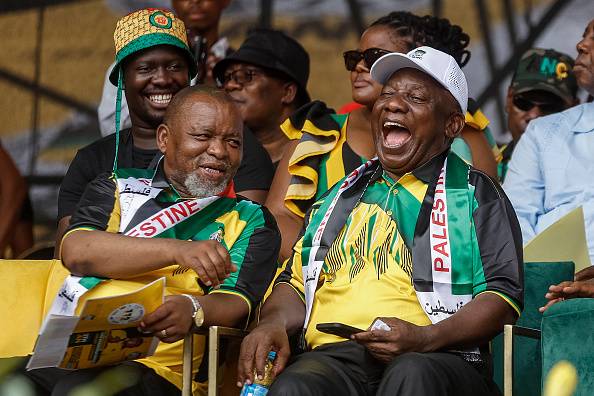Thursday evening’s State of the Union had nearly as many fashion moments as a major award ceremony’s red carpet.
There was the coalition of about two dozen Democratic women wearing all-white, a statement in support of women’s rights. They previously employed this gesture in 2019, when female Democrats wore white as a tribute to the suffragists who fought for women’s right to vote.
Rep. Marjorie Taylor Greene (R-Ga.) wore a T-shirt reading “SAY HER NAME: LAKEN RILEY” — borrowing the phrase popularized by the Black Lives Matter movement to memorialize people killed by police to bring attention to the killing of a Georgia college student, allegedly by a Venezuelan man who authorities say crossed the U.S. border unlawfully in 2022. (Earlier Thursday, the House passed an act in Riley’s name mandating federal detention for immigrants who commit theft or burglary earlier.)
As President Biden entered the chamber, Greene weaponized her accessories, holding forth a pin with Riley’s name, imploring him, “Say her name!” Minutes later, she posted a video of the exchange on Instagram, implying that the president had ignored her. When she interrupted him in the midst of his speech, he picked up his own pin and said her name, offering condolences to her parents.
Nearly every attendee knows that there is no shame in dressing for attention — indeed, that clothes that draw the eye toward them are the purpose of the event. The parents of Evan Gershkovich, the Wall Street Journal reporter who has been detained in Russia on charges of espionage since late March 2023, attended, his mother in a bright red suit, an enormous “FREE EVAN” pin on her lapel.
But there was a bit of glamour, even from odd corners. Such as George Santos, the fabulist congressman who was expelled from the House last year amid accusations that he had used campaign money on personal expenses such as Botox and luxury shopping, returning like a “RuPaul’s Drag Race” villain in a sparkly, studded collar with coordinating silver shoes.
Or the first lady, Dr. Jill Biden, looking calm in a pale sage suit with a sparkling brooch. Vice President Harris, who always wears clothing well, if not with any special panache, looked unflappable in a lean black blazer and white shirt, her top two buttons undone.
In between, there were countless smaller statements of allegiances and protest. Many lawmakers wore more buttons on their lapels than a TGI Fridays waiter. Several attendees wore simple rectangular stickers reading “153,” marking the number of days that Israeli hostages have been held by Hamas. Former House speaker Nancy Pelosi (D-Calif.) opted for a red and blue necklace, a fashion statement of bipartisanship that she also wore with her white suit in 2019, when she sat prominently behind President Donald Trump.
At a time when Donald Trump hawks sneakers and Santos makes news for shopping at Hermès and Ferragamo, clothing has become an essential tool for politicking. Santos’s flashy ensemble was a pretense to announce that he will once again run for Congress.
The State of the Union is the awards show of the electoral process — a time for the stars of politics to hobnob and make their positions known. And it is a sartorial performance of allure and power.
It’s over an hour of uninterrupted television, for a country that is more used to streaming than prime time, when cameras linger across the crowd over and over, allowing any tiny gesture to become national news. Social media and the microanalyses of every political statement and gaffe mean that the audience is eager to take in the messages. The key difference between this spectacle and that of an awards show: With a politician’s T-shirt or baseball cap, unlike a couture gown, anyone can get a look.



